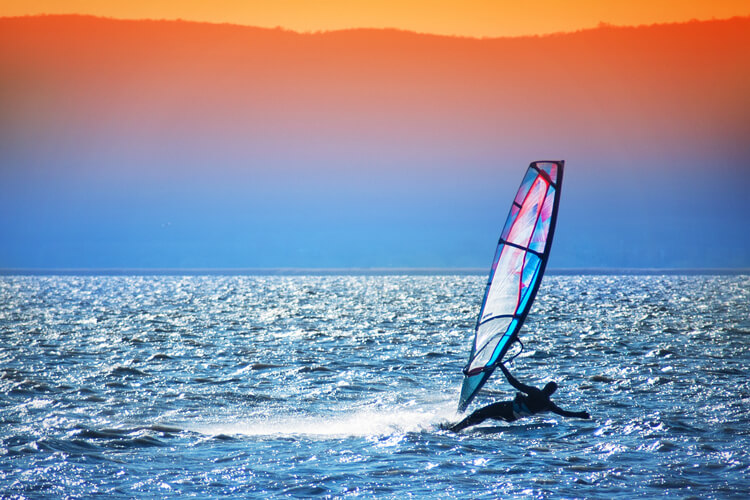Windsurfing is a thrilling water sport. Learn how to sail a windsurfer. Discover the original Windjammer's boardsailing short course for beginners.
The Windjammer's booklet - or user's manual - showcased a basic yet perfect introduction to windsurfing.
The instructions are timeless and feature everything you need to know to master the basics of boardsailing.
Have you got a windsurf board and sail? Start sailing now.
Choosing a Location
When first learning to boardsail, a good location is essential. You should look for a small lake or lagoon about 100 to 200 yards across.
Since it is easiest at first to sail on a reach or across the wind, look for a place where the wind is blowing parallel to the shore - that way, if you can sail out, you can also sail back in.
Avoid places where there are powerboats. Their wakes make it very difficult to balance.
Do not attempt to learn to boardsail in the ocean. Sailing out through the surf is for experienced sailors only.
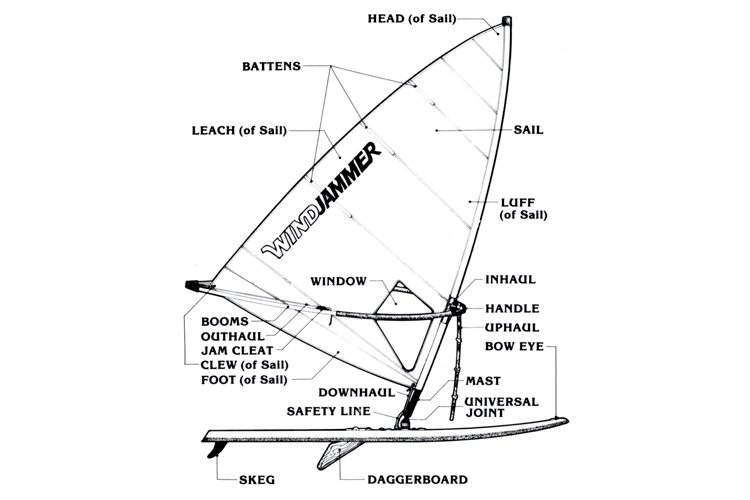
Wind Strength and Direction
If the wind is blowing stronger than 7 to 10 miles per hour, wait for another time to learn.
Winds as strong as that are more than a beginner can handle and can make the learning experience a very frustrating one.
A 3-to-5 miles per hour wind would be ideal.
As you get better, you will be able to handle more and more wind and will seek out windy conditions for the thrilling ride they provide, but when just starting out, too much wind will keep pulling you over.
As mentioned before, the wind direction should be parallel to the shore.
If you cannot sail in a location with those conditions, be very careful not to allow yourself to blow too far from shore.
If the wind is blowing directly offshore, you can blow a long way in a hurry while learning.
As a way to counter this, you can use a tether line attached to a dock or the shore (or a small anchor) to pull yourself back.
Thirty to 50 yards of line should be enough.
Tie the line to your mast base or daggerboard handle.
As a last resort, you should be familiar enough with your rig to be able to disassemble it in the water, roll up the sail on the mast, place the rig between your legs on the board, and paddle it back.
Don't worry - many beginners paddle their boards back to shore the first time out. If possible, the wind should be "clean," that is, it should approach your position relatively unobstructed.
Large buildings or trees directly up-wind can cause the wind to swirl around, making it difficult to keep the sail full.
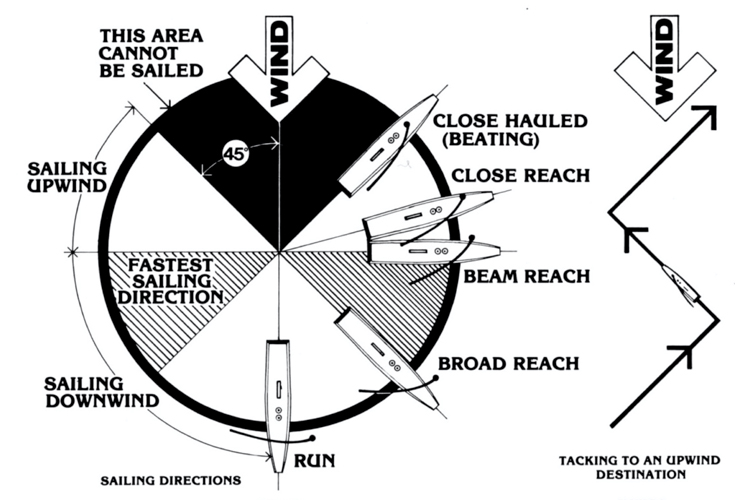
Practicing on Land
Before you try to haul the sail up for the first time in the water, get the feel of the wind's pull on your rig by assembling the mast, booms, and sail on shore.
Place the mast base in the sand or on the grass, haul up the sail, and allow it to "luff" or blow downwind like a weathervane.
Imagine the direction the board would be pointing.
Position your feet on the board's centerline, one on either side of the mast (about 12" to 18" apart), and haul in the sail.
You can get a very good feel for what the pull on the sail will be like in the water without the additional problems of balance, waves, etc.
A little practice like this can give you valuable experience and confidence.
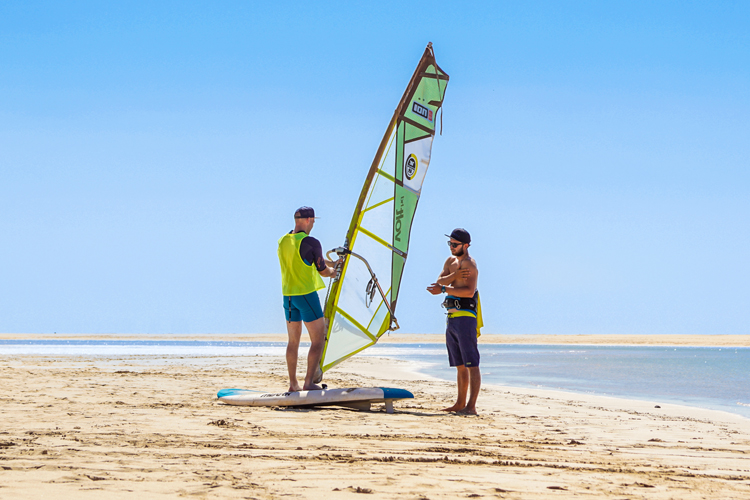
Preparing the Board's Surface
The deck skin of your windsurf board offers very good traction when properly conditioned.
However, when it is new, the polyethylene deck may be too slippery for your liking.
The best way to reduce the slipperiness is to scoop up a handful of wet beach sand and rub it on the deck with your hands until it no longer feels slippery.
If there is no sand where you sail, you can simply scuff up the deck with your bare feet.
Don't stand on the board while it is on the ground if the fin is in place - it could break off.
The deck should not look rough; it should just not feel slippery. The longer your board is used, the better the deck's traction.
As with any board, don't lay on it wearing suntan oil, or it will become very slick when you stand up.
Note: Always clean the mast step holes to remove all sand before inserting the mast base.
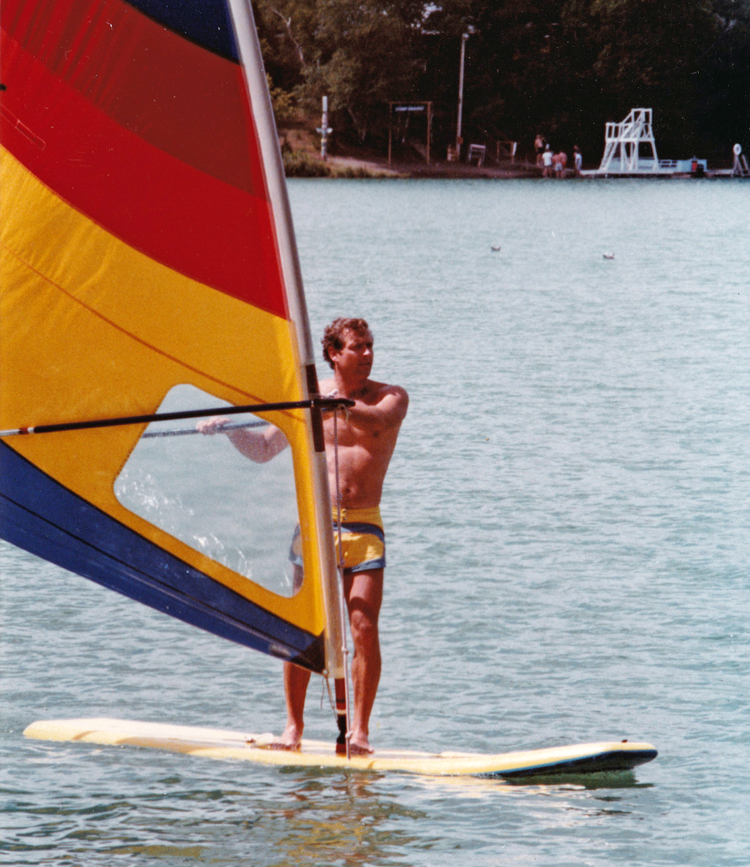
Going Sailing
Assemble the board and rig as described in the assembly manual included with your windsurfing kit.
Make sure there is no sand in the mast step hole before you insert the mast base.
Insert the mast base, lock it in place, and walk the entire rig out to waist-deep water. Arrange the board so that it is pointing in the direction you wish to sail.
Your back should be to the wind, and the sail should be laying in the water downwind and at a 90-degree angle to the board.
Kneel on the board with one knee on either side of the mast facing the sail and retrieve the uphaul line.
Note: It's easier to rotate the nose of the board around to get the line than it is to try and crawl out the mast to find it.
Holding the line, stand up with one foot on either side of the mast base.
Your feet should be on the board's centerline about 12 inches apart and with the mast base right in the middle.
Hauling Up the Sail
With your back to the wind, lean back slightly and pull in on the uphaul line.
Keep your back straight and use your leg muscles to lift the sail out of the water.
It will be heavy at first, but as you lift the sail and the water starts to run off, it will come up easier and easier.
Use a hand-over-hand motion to the uphaul line and pull the sail up until you can take hold of the handle at the front of the booms.
Pull in until the back of the booms are out of the water and allow the sail to blow downwind like a weather vane.
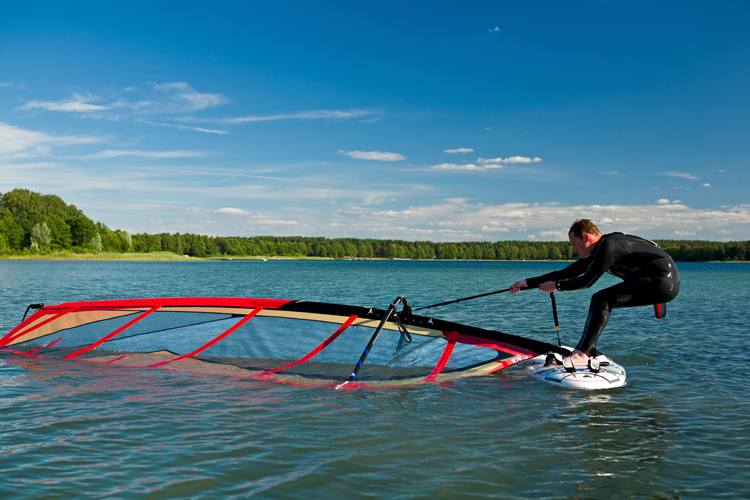
Starting to Sail
Reach your mast hand - the hand closest to the nose of the board - over the hand holding onto the boom handle and grasp the boom 6'' to 8'' in the back of the mast.
Lean the mast toward the nose of the board on the board's centerline while you release the hand on the front of the boom.
Move that hand your shoulder's width back to grasp the boom - this is your "sheet hand."
Pull in slightly with the sheet hand while leaning the mast toward the nose of the board.
Slide your rear foot back about 12" more. This should all be done quickly and in one smooth move.
You should now sail off in a straight line.
At this point, what usually happens to beginners is that the board begs to turn upwind, the sail luffs, and they fall over backward.
The reason is the mast is not leaned far enough toward the nose of the board, and the board turns into the wind.
Remember to lean the mast way forward.
If you start to turn away from the wind, just lean it back a bit to resume a straight course.
Once sailing, don't pull the sail in too far. If you start sailing sideways, you've got it pulled in too far.
The wind must be released from the rear of the sail in order for you to move forward.
If a gust of wind begins to pull you off balance, sheet out quickly with your rear hand to dump some wind out of the sail.
As soon as you recover, pull back in with your sheet hand and resume your course.
If you get pulled forward too far, don't let go with your mast hand.
Always let go with your sheet hand first. As soon as you release your sheet hand, the sail will stop trying to pull you over.
If you release the mast hand first, the sail will continue to pull, and you will have to drop it in the water and start from scratch.
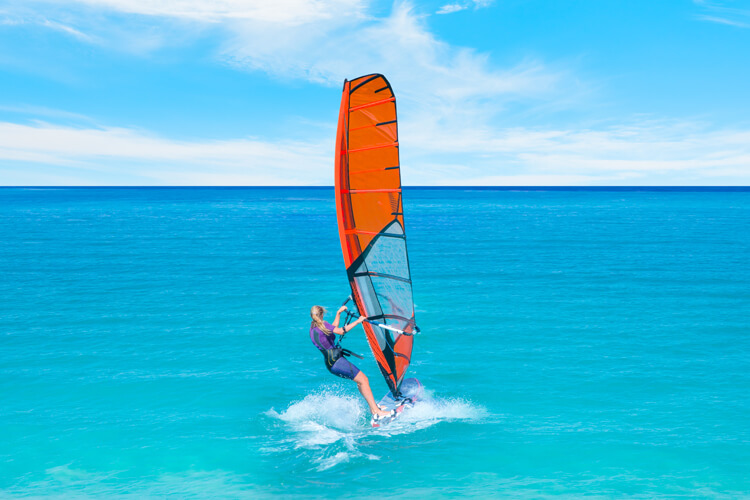
Steering
Turning the board is accomplished simply by leaning the mast on the board's centerline toward the nose to turn away from the wind (head off) or toward the tail to turn into the wind (head up).
What you are doing when you tilt the mast forward or back is moving the board's "center of effort" ahead of or behind its "center of lateral resistance" - the daggerboard.
When the mast is forward, the center of effort is in front of the daggerboard, and the board heads off.
When the center of effort moves back, the tail of the board comes around, and the board heads into the wind.
Turning while running downwind is accomplished by leaning the mast to the left or right, but you are still doing the same thing.
The moveable center of effort is the key to the free sail system and the reason sailboards don't need a rudder to steer.
That's all there is to it.
It may sound complicated at first, but it's really not - just keep trying, and you'll get it.
Proper Body Position for Sailing
When starting out, try to keep your front arm bent at the elbow at all times.
Adjust the pull of the sail by letting out or pulling in with your sheet (rear) hand.
Keep your back straight and shoulders back - don't bend at the waist and let your rear hang out.
Keep the boom in fairly close to your chest so that the mast stays on the board's centerline - don't lean it away from you.
Keep your front leg fairly straight and pointed toward the front of the board. Through it, you transfer the sail's force to drive the board.
Your rear leg should be slightly bent to help you adjust your balance.
In stronger winds, you will move your feet out closer to the windward rail and lean back more to counter the increased pull on the sail.
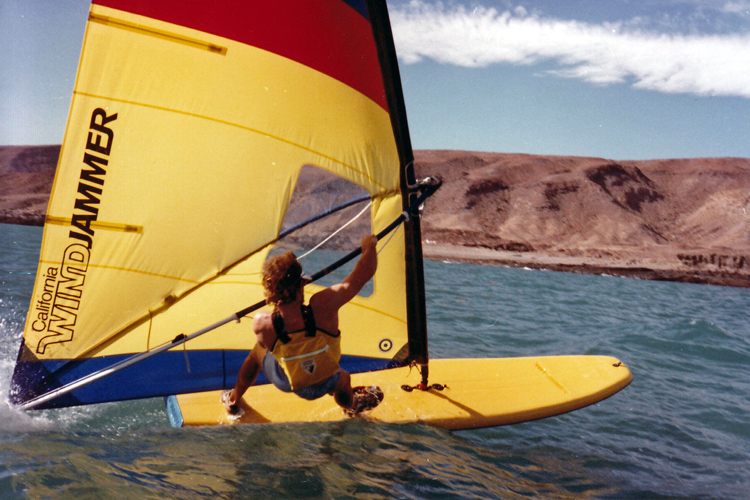
Tacking or Coming About
Since it is impossible to sail directly into the wind, to travel upwind, you must sail on a series of tacks close-hauled, making a zig-zag course until you reach your destination.
Coming about is turning to the new upwind tack by bringing the nose of the board across the wind.
To come about when sailing close-hauled, first, lean the mast way back until the board heads up into the wind.
Drop the back end of the boom into the water to slow you down and assist in pivoting the board.
Allow the sail to luff and take hold of the uphaul line or the boom handle.
Step around in front of the mast as the board heads up using small steps and staying close to the mast base.
Lean the mast to the side of the board toward which you wish to turn, and the nose of the board will come around in that direction.
This is called a "rope turn."
As the board comes around to the new direction, keep your back to the wind by continuing to step around the mast base.
When the board is pointing in the direction you now wish to sail, tip the mast forward, sheet in as before, and sail off on the new course.
Jibing
If you are sailing downwind on a broad reach and wish to turn so that the wind is coming from the other side, first lean the mast toward the nose of the board so that you begin to sail straight downwind.
As the board comes around, move your feet until you are standing with one foot on either side of the daggerboard well, centered on the board.
Release your sheet hand from the boom, and holding onto the uphaul line, let the sail swing around over the nose of the board so you can grab the boom with your other hand on the opposite side.
Step forward with your new forward foot slightly and sheet in to set sail in the new direction.
Running
From a broad reach, begin sailing downwind by tilting the mast toward the nose of the board.
As it begins to head downwind, step around so that both feet are placed equally on opposite sides of the daggerboard, well facing forward.
Bring the sail around so that it is approximately perpendicular to the board, with the mast leaning to the ski windward side.
Look through the sail window and steer the board by leaning the boom and mast to the left or right instead of forward or back.
Leaning it to the right makes the board turn left and vice versa.
Balance is difficult in this position, so you may want to assume a slightly lower stance with knees bent more.
Breaking Down the Rig for Paddling
Should you ever be completely becalmed, break a piece of equipment, or find yourself in more wind than you can handle, you can partially disassemble your rig in the water and paddle back to shore.
First, drop the sail and release the mast base from the mast step.
Pull the mast across the board so you can reach the outhaul line on either side of the booms.
Release the outhaul line from the cleat and let it all the way out through the grommet in the clew of the sail.
Tie off the excess outhaul line.
You may then simply gather up the sail around the mast and rotate the booms up against the sail and mast, place the mast and booms down the centerline of the board, kneel on either side of the mast, and paddle.
The mast does not float, so don't completely disassemble the rig out in the water.
The daggerboard may be removed and placed on the deck to reduce drag if you wish.
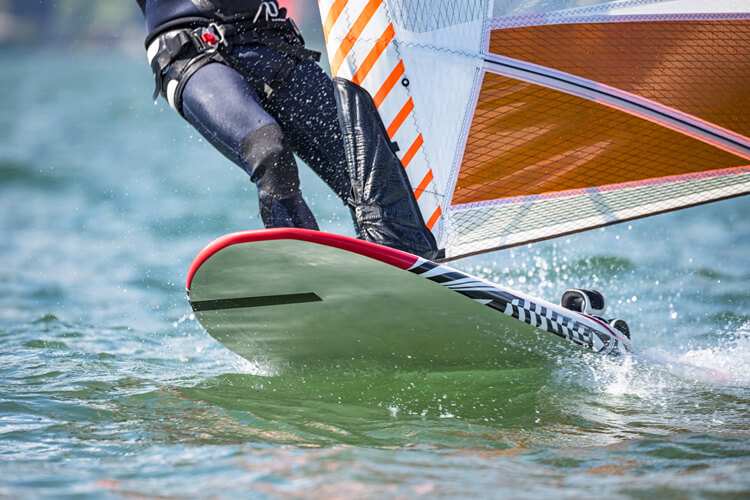
Summary Tips
Safety
- When participating in any open-water sport, it is always a good idea to wear a Coast Guard-approved life jacket;
- Stay close to shore while learning and never boardsail alone;
- Choose your location carefully. Avoid locations with jagged rocks, strong currents, strong offshore winds, waves, powerboats, and overhead power lines. For obvious reasons, do not sail when there is lightning in the area, even though the high winds may tempt you. Avoid sailing in the surf until you are experienced enough to handle it;
Sailing
- Pulling in the sail without heading upwind is hard for most beginners. Remember, you have to lean the mast toward the nose of the board to get going. Once sailing, ease the mast back to hold a straight course;
- If the wind pulls too hard, hold on with the mast hand and release the sheet hand. Always release the sheet hand first to dump wind;
- Learn the right-of-way rules for sailcraft and other boats;
- Check the local regulations where you sail. Sailing may be restricted to certain hours or designated areas for your safety. It's up to you to inquire;
Equipment
- The deck of a new board may need to be roughed up with a handful of sand to make it less slick. Go easy; just rub until it feels right, don't overdo it;
- When sailing in salt water, always rinse off all your equipment with fresh water before putting it away. Dry your sail before rolling or folding it up for storage;
- Clean out all sand from the mast step hole before inserting the mast base;
- If using roof racks to transport your windsurfing kit, use the soft type if possible, as they don't dent the rails of your board. If you see any tiedown strap digging into the rails, use a piece of cardboard at the tiedown point to spread the load and keep it from cutting into the board. Dents will come out slowly, but it's best not to get them in the first place. When transporting on top of a car, place the board top side down with the nose to the rear of the car;
